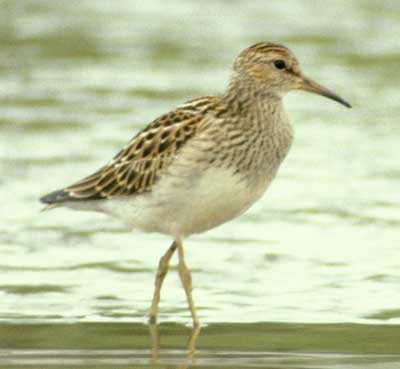Pectoral Sandpiper, Calidris melanotos
High-Priority Species ListBreeding
The highest breeding densities occur along the arctic coastal plain of northern Alaska and east-central Siberia. Lower densities occur in more inland locations or peripheral parts of their breeding range (i.e., west coast of Alaska; Holmes and Pitelka 1998). The abundance of the species within any one breeding area fluctuates dramatically from year-to-year. In an 11 year period between 1955 and 1965, the number of territorial males ranged from 7 to 37/km2 in Barrow, Alaska (Holmes and Pitelka 1998). Similar changes in density have been recorded in recent years (B. Kempenaers and R. Lanctot, unpubl.). Breeding Pectoral Sandpipers are found in good numbers throughout the National Petroleum Reserve - Alaska (NPR-A) and east to the Canadian border. Moderate densities of birds have been reported at Barrow, Teshekpuk Lake, and Prudhoe Bay (Troy and Wickliffe 1990, R. Lanctot, unpubl. data; J. Liebezeit, unpubl. data); nest densities in these areas average between 5.4 and 11.5 nests/km2. Additional areas within the NPR-A also have high densities based on surveys conducted in the late 1990s and early 2000s (J. Bart, unpubl.).
Pre-breeding
Thousands to tens of thousands migrate through the central YKD in mid-May. These birds are suspected of being migrants on their way to Siberia to breed.
Post-breeding
Male Pectoral Sandpipers depart their breeding areas quickly, with the majority moving south to subarctic wetlands in the northern prairie regions. Females and their offspring, in contrast, congregate in tundra habitats near the coast of the Arctic Ocean where they may stay for several weeks (Connors et al. 1979). Juveniles are present in western Alaska in small flocks from September to mid-October where they occur in coastal habitats, frequently with Sharp-tailed Sandpipers.
Sampling locations: Breeding Pectoral Sandpipers will primarily be sampled on the North Slope at established camps at Barrow, Teshekpuk Lake, Prudhoe Bay, Canning River, and surrounding areas. Secondary sampling will be conducted during pre- and post-breeding periods on the north and central YKD and during post-breeding on the North Slope.
Sampling timeframe: Pre-breeding birds will be sampled during May on the central YKD, breeding birds will be sampled during June on the North Slope, and post-breeding birds will be sampled from July through early September on the North Slope and August-September on the north and central YKD.
Sample demographics: Adults will be sampled during pre-breeding and breeding, and adults and juveniles will be sampled during fall staging.
Methods of capture: Birds breeding on the North Slope will have fecal samples collected or will be live-trapped on nests using bow traps. Pre- and post-breeding birds on the central YKD will be live-trapped using bow traps, walk-in traps, mist nets, and/or rocket nets. Fecal sampling will occur at both pre- and post-breeding areas at high tide roosts or from areas where birds were observed feeding. Large numbers of birds could be collected at any of these sites if needed.
Ability to capture birds: Breeding locations: As part of an intensive study of Pectoral Sandpipers at Barrow, 96 and 187 adults were captured in 2004 and 2005, respectively (B. Kempenaers and R. Lanctot, unpubl.). We anticipate similar numbers of birds can be captured in the coming year at this site, and that comparable numbers can be captured at Teshekpuk Lake, Prudhoe Bay, and the Canning River. The ability to collect fecal samples should also increase our sample size as males traditionally defecate on hummocks that are used in territorial displays. Pre-breeding locations: No attempt has been made to capture Pectoral Sandpipers at this time of the year. Given their sheer numbers, it is suspected these birds could be captured with a variety of traps or, at a minimum, collected. Post-breeding locations: This species was captured inadvertently on the central YKD as biologists attempted to capture Sharp-tailed Sandpipers during the 2005 field season.
Other targeted species: At the proposed primary breeding sites it will be possible to sample small to moderate numbers of Dunlin, Long-billed Dowitchers, and Buff-breasted Sandpipers. On the pre-breeding locations on the YKD, it will be possibly to sample (Long-billed Dowitcher). At the proposed post-breeding location on the YKD, it will be possible to sample Dunlin and Sharp-tailed Sandpipers.
Contact: Richard Lanctot
Yukon Delta NWR
Arctic NWR
U.S. Geological Survey
Contact: Robert Gill
Connors, P.G., J.P. Myers, and F.A. Pitelka. 1979. Seasonal habitat use by arctic Alaskan shorebirds. Studies in Avian Biology 1:307-315.
U.S. Interagency Strategic Plan. 2006. Final Draft: An early detection system for Asian H5N1 highly pathogenic avian influenza in wild migratory birds.
Holmes, R.T., and F.A. Pitelka. 1998. Pectoral Sandpiper (Calidris melanotos). In The Birds of North America, No. 348 (A. Poole, and F. Gill, eds.). The Birds of North America, Inc., Philadelphia, PA.
Taylor, A.R., A.N. Powell and R.B. Lanctot. In press. Pre-migratory movements and physiology of shorebirds staging on Alaska’s North Slope. OCS Study MMS 2006-xxx, Annual Report No. 11, Federal Fiscal Year 2005, pages xxx-xxx.
Troy, D.M. and J.K. Wickliffe. 1990. Trends in bird use of the Pt. McIntyre Reference Area 1981-1989.Unpubl. report by Troy Ecological Research Associates for BP Exploration (Alaska) Inc.

Ranking Score: 13.0
Asian H5N1 ranking criteria for Pectoral Sandpiper, Calidris melanotos.
Total of partial contact with Asia1 |
Contact with known "hot spot"2 |
Habitat used in Asia3 |
Pop. in Alaska4 |
Can samples be obtained? |
Score |
3.0 |
1.0 |
4.0 |
3.0 |
2.0 |
13.0 |
Greater than 50% of population nests in Russia west to e. Taimyr Penin. |
No known use of AI-infected areas |
Breeds marshy/grassy tundra; postbreeding uses brackish ponds freshwater marshes |
Est. 200,000 - 300,000 |
Could be difficult to obtain target number |

